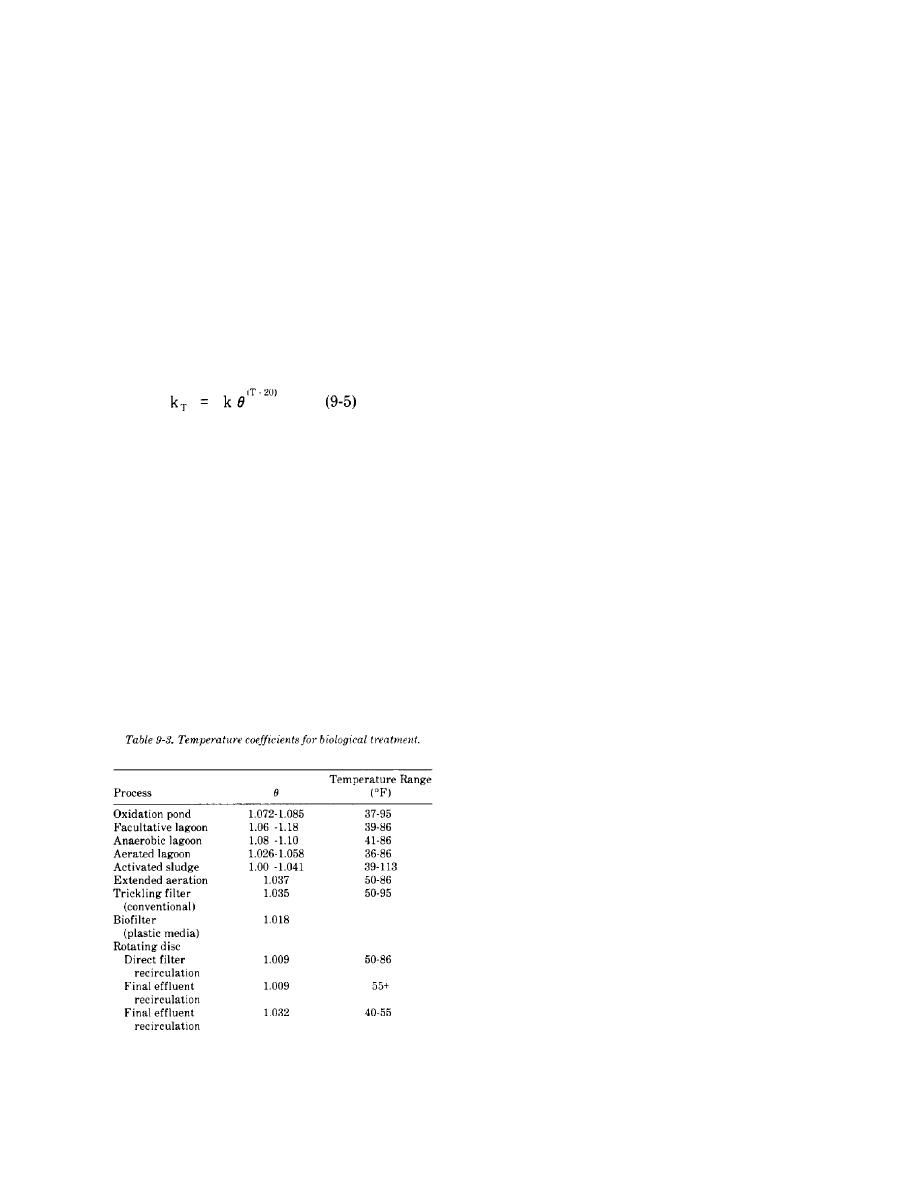
TM 5-852-5/AFR 88-19, Volume 5
(a) Special requirement. A permanent ice
(3) Activated sludge systems. Systems that have
cover must be avoided in the aeration compartments
been successfully used in cold regions include
of activated sludge systems. An ice cover will inhibit
conventional and pure-oxygen activated sludge,
atmospheric aeration and will entrap solids, both of
contact stabilization, and extended aeration con-
which reduce treatment efficiency. The design must
cepts, both in package plants and in oxidation
provide for a minimum of exposed liquid surface
ditches. Basic design criteria for these processes can
area to reduce heat losses. An unheated shelter, a
be found in TM 5-814-3/AFM 88-11, Vol.3. When
temporary tank cover or a wind break is required
the system is enclosed and incoming waste-water
during the winter. Clarifiers associated with these
temperatures exceed 50 degrees F, basic design
systems will require similar protection to avoid
criteria will apply. Special measures are necessary
freezing and to inhibit density currents. A
only when incoming wastewaters are below 50
continuously heated building is not necessary to
degrees F or if a significant temperature drop is
maintain treatment efficiency. Operator comfort and
expected within the system. All of the biological
convenience are the only justifications for such
reaction rates involved are temperature sensitive,
energy inputs. If the incoming sewage is 50 degrees
and must be adjusted using:
F or warmer there is sufficient heat in the liquid to
sustain a protected treatment process. A standby
heat source and emergency power are recommended
for extended power failures and other emergencies.
where
(b) Extended aeration. Extended aeration
units have been successfully operated with liquid
kT = reaction rate coefficient at temperature T
temperatures as low as 33 degrees F and have still
k20 = reaction rate at 20 degrees C
produced high quality effluent. Design organic
T = design wastewater temperature, degrees C
loadings (food/microorganism ratio) of up to 0.08 lb
2 = temperature coeeficient.
BOD (biochemical oxygen demand)/lb MLSS/day,
and mixed liquor suspended solids (MLSS) concen-
The 2 values given in table 9-3 will be used in
trations of 3000-40000 mg/L are recommended for
equation 9-5 to adjust the reaction rate for the
low temperature operation. Small packaged treat-
design wastewater temperature. The basic reaction
ment units must be covered and must be protected
rate coefficients are found in TM 5-814-3/AFM 88-
from the wind. Pumps, motors, blowers, external
11, Vol.3.
pipes, valves and similar appurtenances will require
heat as well as a protective shelter. These systems
must not be oversized or overdesigned with respect
to hydraulic capacity, because low organic loadings
usually result in poor performance. Dual units are
required for low, intermittent flows at remote
installations. Only one unit is operated during low
flow periods. This unit is operated with a MLSS
concentration. Sludge is then transferred to the
second unit during peak flow periods allowing an
immediate start-up. Figure 9-5 illustrates the special
features of an oxidation ditch in the Subarctic. The
aeration basin has vertical sidewalls and a vertical
central divider. This reduces exposed surface area
and heat losses by about 32% as compared to the
conventional ditch with sloping sidewalls and center
island. The only heated space in this treatment
system is the office/laboratory clarifier equipment
and aeration brushes are housed in simple concrete
block construction. Condensation and ice forms on
the interior surfaces of exterior walls. Thus
switches, control panels, etc., must be located on
dry interior walls. These features are not unique to
oxidation ditches and can usually be incorporated
into other systems as well.
9-7



 Previous Page
Previous Page
